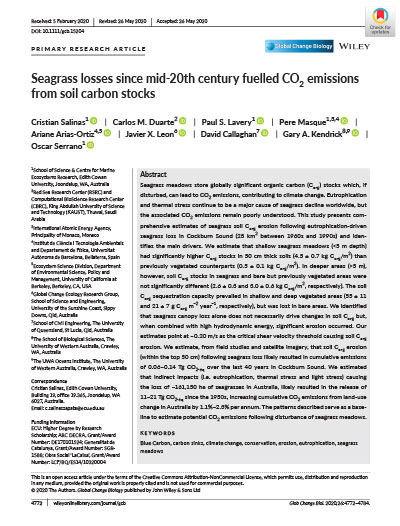Seagrass losses since mid-20th century fuelled CO2 emissions from soil carbon stocks

Author:
Cristian Salinas, Carlos M. Duarte, Paul S. Lavery, Pere Masque, Ariane Arias-Ortiz, Javier X. Leon, David Callaghan, Gary A. Kendrick, Oscar Serrano
Publication Year:
2020
Citation:
Salinas, Cristian, Carlos M. Duarte, Paul S. Lavery, Pere Masque, Ariane Arias‐Ortiz, Javier X. Leon, David Callaghan, Gary A. Kendrick, and Oscar Serrano. “Seagrass Losses since Mid‐20th Century Fuelled CO 2 Emissions from Soil Carbon Stocks.” Global Change Biology 26, no. 9 (September 2020): 4772–84. https://doi.org/10.1111/gcb.15204.
Description:
Seagrass meadows store globally significant organic carbon (Corg) stocks which, if disturbed, can lead to CO2 emissions, contributing to climate change. Eutrophication and thermal stress continue to be a major cause of seagrass decline worldwide, but the associated CO2 emissions remain poorly understood. This study presents comprehensive estimates of seagrass soil Corg erosion following eutrophication-driven seagrass loss in Cockburn Sound (23 km2 b etween 1 960s a nd 1 990s) a nd i dentifies the main drivers. We estimate that shallow seagrass meadows (<5 m depth) had significantly higher Corg stocks in 50 cm thick soils (4.5 ± 0.7 kg Corg/m2) than previously vegetated counterparts (0.5 ± 0.1 kg Corg/m2). In deeper areas (>5 m), however, soil Corg stocks in seagrass and bare but previously vegetated areas were not significantly different (2.6 ± 0.3 and 3.0 ± 0.6 kg Corg/m2, respectively). The soil Corg sequestration capacity prevailed in shallow and deep vegetated areas (55 ± 11 and 21 ± 7 g Corg m−2 year−1, respectively), but was lost in bare areas. We identified that seagrass canopy loss alone does not necessarily drive changes in soil Corg but, when combined with high hydrodynamic energy, significant erosion occurred. Our estimates point at ~0.20 m/s as the critical shear velocity threshold causing soil Corg erosion. We estimate, from field studies and satellite imagery, that soil Corg erosion (within the top 50 cm) following seagrass loss likely resulted in cumulative emissions of 0.06–0.14 Tg CO2-eq over the last 40 years in Cockburn Sound. We estimated that indirect impacts (i.e. eutrophication, thermal stress and light stress) causing the loss of ~161,150 ha of seagrasses in Australia, likely resulted in the release of 11–21 Tg CO2-eq since the 1950s, increasing cumulative CO2 emissions from land-use change in Australia by 1.1%–2.3% per annum. The patterns described serve as a baseline to estimate potential CO2 emissions following disturbance of seagrass meadows.
See related content:
- Explore the site by related topics: Habitat and Biodiversity Loss
